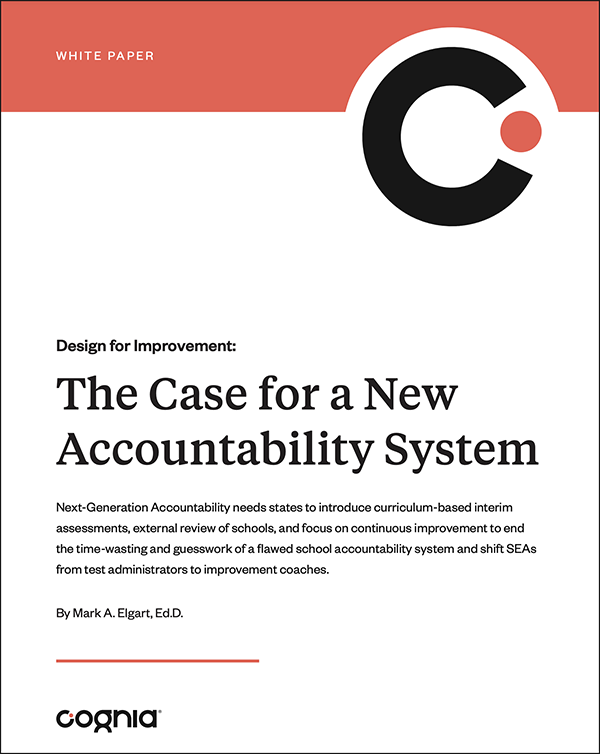Next-generation accountability needs states to introduce curriculum-based interim assessments, external review of schools, and a focus on continuous improvement to end the time-wasting and guesswork of a flawed school accountability system. This will shift State Education Agencies from test administrators to improvement coaches.
Our current educational accountability system, which depends on large-scale, summative assessments aligned with state standards has been, at best, a missed opportunity. Although institutions are expected to improve teaching and learning based on assessment results, these assessments only provide evidence at the end of the academic year, restricting any real value in improving learning that could inform teacher practices during the academic year. One could argue that the major accomplishment of this system has been to teach us the limitations of these assessments and to create an assessment monopoly led by a few companies that are not heavily invested in innovation.
Ranking institutional performance primarily based on a year-end summative assessment is a misuse of the purpose of assessment. It neglects measures of institutional performance that determine what practices are working and what strategies need to be implemented to improve the effectiveness of a school and its instruction. Assessment results are evidence that should be considered in a comprehensive evaluation of an institution but cannot be the sole instrument to evaluate an institution.
But if our accountability system provided schools with timely, useful information that illustrates what practices are working, what behaviors need to change, and how best to make improvements, we could guide and assist efforts to improve.
In an approach that more than a dozen states are now beginning to explore, we can replace end-of-year summative assessments with interim assessments that provide actionable information and preserve instructional days. By embedding assessments into the teaching and learning process, aligned to the curriculum, immediate actions can be taken to improve teaching and learning. If we are truly committed to ensuring that every child is successful in their learning, then we can and must change our accountability systems to do just that.
With the student as the focal point of the design of the new accountability system, policymakers should engage with educators to drive change
What a New Accountability System Looks Like
With the student as the focal point of the design of the new accountability system, policymakers should engage with educators to drive change in three areas. Knowing what we know now, a redesigned accountability system should have three key elements:
1. Actionable data through curriculum-based assessments offered at intervals throughout the year that can also provide a summative score. These assessments break the summative assessment into multiple shorter testing periods, ensure students are tested on what they learn, provide timely feedback to students, teachers, parents, and families, and produce for policymakers a summative score that can be combined with other information. They provide for a more accurate view of a school’s quality, performance, and its efforts to improve. Emboldened by federal flexibility to test assessments that provide information that can be used during the school year, thirteen states, have already changed their programs to provide multiple information points rather than just relying on too-late summative data. These states include Alaska, Delaware, Florida, Georgia, Indiana, Kansas, Louisiana, Maine, Montana, Nebraska, North Carolina, Texas, and Virginia.
2. Independent third-party evaluation. A comprehensive, periodic third-party evaluation –like that provided in scores of countries, including Sweden and Great Britain—provides an independent, objective analysis of what an institution is doing well and what actions it must take to do better. A formal evaluation is based on standards that describe what an effective institution does and weighs evidence—including student performance data—to identify the areas of effectiveness and improvement that need to be addressed. School evaluation can be enhanced further by analyzing the root causes of improvement needs and provide clear direction on what behaviors and practices need to change. Multiple providers, including WestED, Cognia, CenterPoint, American Institutes of Research, Insight Education Group Education Resources Consortium, and others provide third-party diagnostic school review services, which focus on factors—instruction, quality of curriculum, leadership, and data on student learning—that research has shown makes a difference in student learning. We know that this is an effective strategy because states that have adopted diagnostic school reviews have seen significant increases in the performance of their lowest-performing schools. For example, state departments of education and schools that engage with Cognia for diagnostic review and subsequent interventions demonstrate noteworthy rates of exiting Comprehensive Support and Improvement (CSI) status. The results?
- 40% of designated South Carolina schools were no longer identified as needing Improvement
- 69% of Kentucky schools were no longer identified as needing improvement
- 56% of schools designated in 2018 that partnered with Cognia for diagnostic reviews were no longer identified as needing improvement by 2022
3. Focus on continuous improvement. While institutions throughout the United States annually review, revise, and adopt school improvement plans to meet state and federal (Title I) requirements, these efforts often fail to guide and achieve meaningful improvement. Improvement is not a compliance activity or a plan, but embedded behaviors within the culture of a school that constantly focus on the conditions, processes, and practices that will improve teaching and learning by regularly identifying the behaviors that must be maintained and those that must change.
Key benefits
First, the design and expectations of such a system focus on what matters most—student learning.
Second, new curriculum-based, periodic assessments have the potential to bring cost savings or be cost neutral to states, particularly if summative assessments that are smaller in scope and take less time for students to complete are permitted.
Third, this approach to accountability can help better align professional learning for teachers that helps them use data to address individual student needs. It also shifts the role of the state education agency (SEA) from a compliance agency and test administrator to an improvement coach. For the first time in memory, the state itself can become an agent of improvement.
This is an opportunity to explore a better way to measure performance that can help schools achieve student and school performance goals that have always been elusive. These goals include closing achievement gaps and seeing schools continuously improve rather than make sporadic progress and sometimes lose ground.
 This article is drawn from Dr. Elgart’s white paper, Design for Improvement: The Case for a New School Accountability System.
This article is drawn from Dr. Elgart’s white paper, Design for Improvement: The Case for a New School Accountability System.
© Cognia Inc.
This article may be republished or reproduced in accordance with The Source Copyright Policy.
The information in this article is given to the reader with the understanding that neither the author nor Cognia is in engaged in rendering any legal or business advice to the user or general public. The views, thoughts, and opinions expressed in this article belong solely to the author(s), and do not necessarily reflect the official policy or position of Cognia, the author’s employer, organization, or other group or individual.

